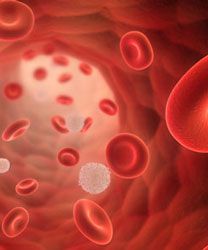Moxetumomab Pasudotox Granted FDA's Priority Review Designation for Hairy Cell Leukemia
Moxetumomab pasudotox has been granted a priority review by the FDA for the treatment of adult patients with hairy cell leukemia (HCL) who have received at least 2 prior lines of therapy, according to AstraZeneca (MedImmune), the developer of the anti-CD22 recombinant immunotoxin.

Moxetumomab pasudotox has been granted a priority review by the FDA for the treatment of adult patients with hairy cell leukemia (HCL) who have received at least 2 prior lines of therapy, according to AstraZeneca (MedImmune), the developer of the anti-CD22 recombinant immunotoxin.
In the phase III 1053 study, on which the application is based, moxetumomab pasudotox achieved the primary endpoint of durable complete response in adult patients with relapsed/refractory HCL. AstraZeneca noted in a press release that results from the study will be presented at an upcoming medical conference.
Under the priority review program, the FDA acts within 6 months of receiving a supplemental application, rather than the standard 10 months. The FDA is scheduled under the Prescription Drug User Fee Act to make a decision on the moxetumomab pasudotox application by the end of the third quarter of 2018.
According to AstraZeneca, Moxetumomab pasudotox is composed of a binding portion of an anti-CD22 antibody fused to a toxin. After binding to CD22, the molecule is internalized, processed and releases its modified protein toxin that inhibits protein translation, leading to apoptotic cell death.
The phase III 1053 study is a single-arm, multicenter clinical trial assessing the efficacy, safety, immunogenicity, and pharmacokinetics of moxetumomab pasudotox monotherapy. Investigators have recruited 80 patients across 34 sites in 14 countries.
In phase I results published in the journal Blood in February, moxetumomab pasudotox eradicated HCL minimal residual disease (MRD) in >50% of complete responders by bone marrow aspirate (BMA) flow cytometry, the most sensitive measure available.
Twenty-one patients were included in the dose-escalation cohort and 33 were treated with 50 μg/kg of moxetumomab pasudotox in a combined cohort. After 88 cycles of treatment in the dose-escalation cohort, investigators did not observe dose-limiting toxicity or hemolytic uremic syndrome (HUS).
Patients received a median of 2 to 3 prior purine analog courses and 50% to 67% of patients received prior treatment with rituximab (Rituxan).
At the 50 μg/kg dose, the overall response rate (ORR) was 91% with a 71% rate of complete response (CR) in the 21-patient extension cohort. In the combined cohort, the ORR was 88% with a CR of 64%. Investigators detected MRD in 8 (40%) patients by BMA flow cytometry.
The median duration of the 21 CRs was 42.4 months. No patient (n = 7) relapsed after consolidation cycles, while 9 of 14 without consolidation relapsed at a median 13.5 months (range, 4.9-42.4;P= .004).
Of the 20 CRs evaluated for MRD, the median CR duration was 35.3 months. Eleven (55%) patients were MRD-negative and 10 remained in CR at end of study, with median CR duration of 42.2 months (range, 16.3-72.1). Nine (45%) CRs were MRD-positive, with a median CR duration of 13.5 months (range, 4.9-42.4) and 8 relapses (P<.0001).
The median duration of MRD-negative CR had not been reached at the time of the analysis, with 9 of 11 patients remaining MRD-negative for a median of 42.1 months (range, 24.0-69.2).
Four patients died of disease progression after relapsing and going off-study in the combined cohort, including 1 with a best response of MRD-positive CR who developed grade 2 HUS after 5 treatment cycles. Two of the 4 were treated off-protocol with pentostatin-rituximab and 1 each with rituximab and rituximab/bendamustine.
Circulating HCL cells cleared in all 9 patients evaluated for lymphocyte subsets before and after treatment, but normal B cells decreased <50% in 3. Total T cells and CD4+ and CD8+ T-cell subsets increased in all patients except 1 with normal pretreatment and posttreatment CD8 counts. Thus, investigators concluded, anti-CD22 moxetumomab pasudotox spared T cells and, with its short half-life, avoided prolonged B-cell depletion.
Reference:
Kreitman RJ, Tallman MS, Robak T, et al. Minimal residual hairy cell leukemia eradication with moxetumomab pasudotox: phase I results and long-term follow-up [published online February 27, 2018].Blood. doi: 10.1182/blood-2017-09-803072.s